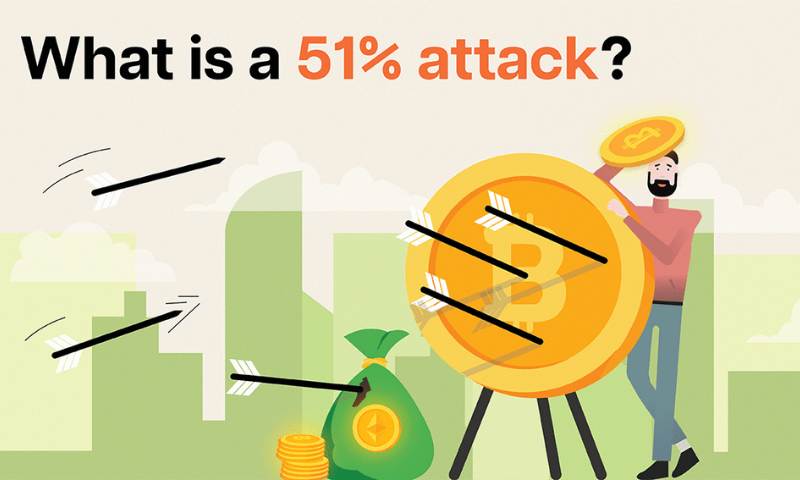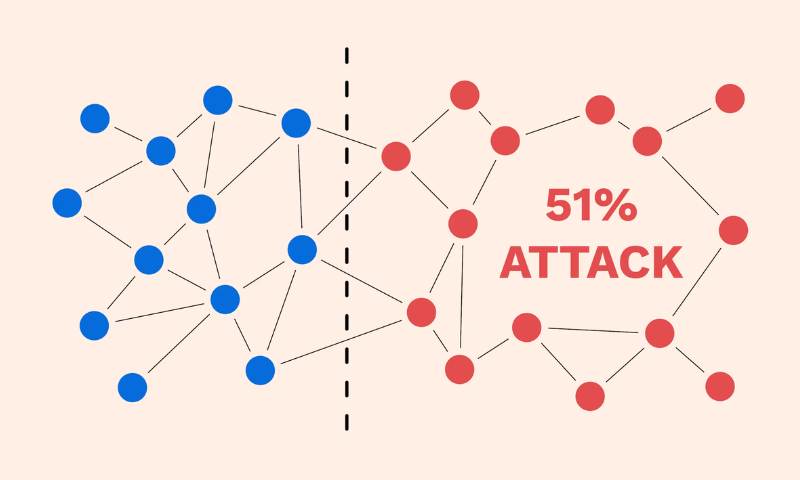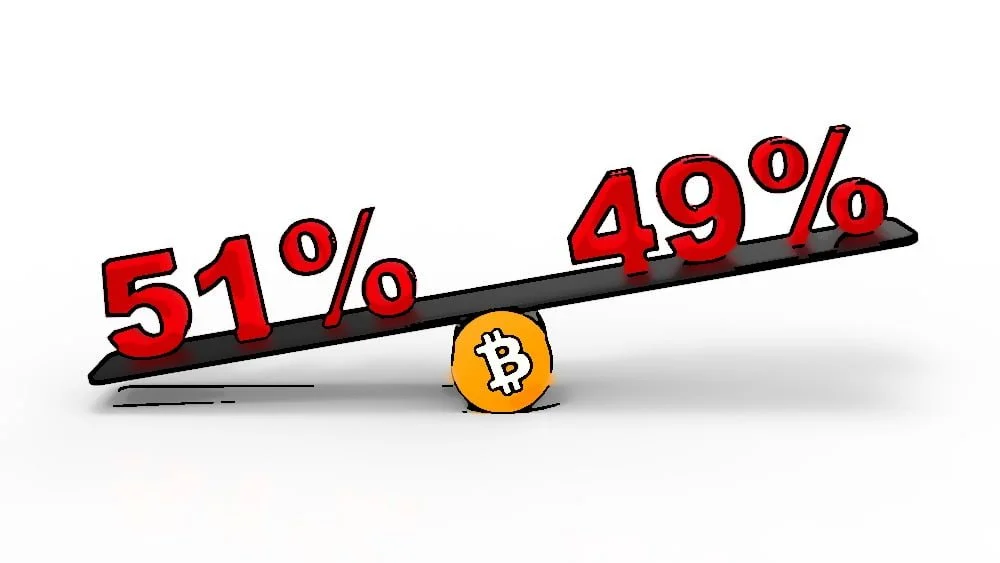What is a 51% attack? Imagine someone taking over a bank, but in the digital world of cryptocurrency. This is the reality of a 51% attack—a threat that could shake the very core of blockchain’s trustworthiness. As a seasoned expert, I’ve seen how it exposes a blockchain’s weak spots by letting attackers have the majority power. They can block new transactions or even reverse completed ones. So, let’s dive deep into this. I’ll show you the nuts and bolts of such an attack, its real damage to crypto assets, and how the crypto community fights back. Stay alert and informed – your digital wealth may depend on it.
Understanding the Mechanics of a 51% Attack
Explaining the Proof of Work System
Do you like playing games? In some, you solve puzzles to win. That’s kind of like the Proof of Work system used in cryptocurrencies such as Bitcoin. Computers in the network race to solve hard puzzles. The first to finish gets to add new info, called a block, to the chain. This also gives them a reward in digital money.
But why puzzles? They help keep the system fair. Solving them takes work, and it stops people from cheating. Plus, it makes sure no one can mess with the data that’s already in the chain.
How Majority Control Leads to Blockchain Vulnerabilities
Now, imagine if one team kept winning the game. That’s like a 51% attack in the crypto world. If one group has over half the power in the network, they can threaten everyone’s digital money. They might allow double spending, which is bad. It’s like spending the same money twice, which isn’t fair or good for trust.
When attackers have most of the power, they can agree on which blocks to add. This may include blocks that help them and hurt others. They can change the rules for their benefit. They could even stop other people’s transactions or reverse their own. That’s stealing, and it’s a big problem.
People might leave the network if they lose trust. It’s scary to think someone can take over and change things. That’s why we work hard to stop this from happening. We have safeguards to keep the network safe. We don’t want a few big players controlling everything.
When we talk about crypto mining domination, we mean this threat. Big groups should not get too powerful. If they do, our money might not be safe. We need a fair game so our digital money stays secure. Let’s work together to make it happen.
The Real-World Impact of a 51% Attack on Cryptocurrency
Double Spending: A Threat to Cryptocurrency Integrity
Imagine you spent money at a store, then got that money back and spent it again. That’s basically double spending. It’s like cheating in a game where you spend your coins twice. This shouldn’t happen, right? Well, in the digital world of cryptocurrencies, a 51% attack makes this possible, and it’s a big problem.
Double spending messes with trust. It threatens the whole idea of cryptocurrency being safe. To stop this, cryptocurrencies use a public ledger. It’s a record book everyone can agree on. But if someone controls more than half of the network’s mining power, they can change this book. They can tell it they never spent their coins when they did. That means they can spend them again somewhere else. Sneaky!
In short, double spending is bad for everyone using the cryptocurrency. It can make people lose faith in it. When trust goes down, it’s hard to get it back. We use things like Proof of Work to keep track of transactions. If that system gets messed up, we have a big problem on our hands.
The Effects of Network Attacks on Cryptocurrency Value
When a 51% attack happens, it shakes up everything. Think of it like a bank robbery. If a bank gets robbed, people get scared. They might not want to put their money there anymore. It’s the same with cryptocurrencies. If there’s an attack, people might think twice before using or investing in it.
The value of money is a bit like a seesaw. It depends on what people think it’s worth. If they’re scared or lose trust, the value goes down. This is what can happen after a 51% attack. If people lose faith, the value can drop fast. This isn’t just a problem for big investors. It’s a big deal for everyone. It can make things harder for folks who use cryptocurrency every day.
Also, attackers can stop other people’s transactions or even reverse them. That creates chaos. Imagine sending money and it never gets there. Or worse, you get money, and then it disappears! That’s not good at all. We want to be sure that when we send or get cryptocurrency, it stays that way. So, we need to keep the network safe to prevent these attacks.
In conclusion, a 51% attack can break the trust we have in cryptocurrencies. It can make double spending possible, hurt the value, and mess up transactions. That’s why us folks working on blockchain security are always on the lookout. We work hard to stop these kinds of attacks before they start. We keep an eye on how mining power is spread out. We also make rules to make sure no one gets too much control. It’s a tough job, but it’s important to protect the money and trust of everyone using cryptocurrencies.
What is a 51% Attack? Unraveling the Threat to Cryptocurrency Security
Monitoring Hash Rate Distributions to Mitigate Centralization Risks
In simple terms, a 51% attack is when a person or group controls most of a cryptocurrency network’s mining power. They can block new transactions from taking place or being confirmed. They can also reverse transactions that were completed while they had control — leading to double spending. If I were to put it plainly, imagine someone having the biggest slice of the pie, and with it, the power to say what goes or what doesn’t.
Such power disrupts the trust and safety we expect in these systems. To explain, blockchain trusts that no single player can control the whole system. A 51% attack breaks this trust. It is a fundamental threat to the core idea of trust-and-verify that blockchains are built on. Picture a group of people playing a game, and suddenly one player makes their own rules because they have the most game pieces. That’s not fair, right?
As a Blockchain Security Analyst, I keep a close eye on hash rate distributions. That’s a fancy term for how mining power is spread out. My goal is to prevent a few big players from holding too much power. It’s like ensuring no single athlete dominates every race in the Olympics. We want everyone to have a fair chance.
Strategies to Avoid Crypto Mining Domination
One major point of action is to watch out for risks in mining pools. Mining pools combine mining efforts to compete more effectively. But if one pool grows too big, it poses a centralization risk. A fair play tactic is creating rules that don’t let any single pool get too powerful. It’s like breaking up teams in school so one doesn’t win all the time by having all the strong players.
Also, I advise against joining large pools if you’re mining. Think about Robin Hood; sometimes helping the small guys, the underdogs, helps keep balance. By spreading your mining power, you help keep the network safe.
Another defense against network attacks is to use better technology for mining. You want to make cheating at the game as hard as possible. This means companies create complex puzzles that are fair but tough to solve. It’s like adding harder questions to a test so the smartest, not the one with the most pencils, wins.
And the high-level stuff? We work on ways to upgrade the system’s rules without centralizing control. That’s how we prevent a majority from ruling the network. Imagine giving each player in a game a rulebook they can’t tweak. It keeps the game fair for everyone, no matter their score.
Lastly, it’s all about making sure the voices of many, not the few, decide what’s fair on the blockchain. This protects the blockchain from becoming someone’s personal toy. It’s as if in a community garden, each gardener’s vote helps decide what gets planted, not just the one with the biggest shovel.
Attackers seek control to bend the rules in their favor. But, our role is to ensure no one ever gets the chance to do that. We’re the guardians of this digital realm, keeping an eye on the walls to prevent any invaders from taking over.
Innovating Blockchain Security Against Future Threats
Enhancing Network Security Protocols
In the race to keep cryptocurrencies safe, we often talk about a 51% attack. This means someone controls more than half of the mining power in a blockchain network. When they do, they can cause big problems, like changing the order of transactions and spending coins more than once.
Imagine a schoolyard game with rules. If one player gets to make all the rules, things get unfair fast. It’s like that with blockchain. One player with too much power can ruin the game for everyone. This risk is why I spend time looking at how the network runs. We need to spot any single player getting too strong.
We use different methods to make sure no one gets this much power. We review how all miners work together. To keep our blockchain safe, we build better ways for it to check itself. With these new rules, we can catch anyone trying to game the system. Making the network stronger stops bad players faster and keeps our cryptocurrency fair and secure.
To explore more about blockchain security and 51% attacks, click here.
Governance Solutions for Decentralized Finance Stability
Keeping DeFi, or decentralized finance, stable is a big job. It’s all about trust. If that trust breaks, people might stop using their crypto. Our goal is to keep that trust solid. First, we tighten up how blockchain rules work. This is called governance. Good governance means no one player can twist the rules to their liking.
We also look at other ways to run blockchains, not just proof of work. These new ways can cut the risk of someone taking over. It helps keep the playing field even for all users.
In the end, it’s like being the referee in our schoolyard game. We make sure everyone plays fair. By changing the rules wisely, we help keep your digital money safe. That’s my job, and I take it seriously because it matters to everyone who uses cryptocurrencies.
By building a stronger foundation for blockchain, we protect the future of money. We work hand in hand with crypto users and tech experts. This team effort makes our digital coins keep their value and remain a safe choice for everyone. We’re not just watching over today’s transactions; we’re guarding the path for a safe crypto future.
To sum up, a 51% attack messes with blockchain trust. We dove into its mechanics, seeing how majority control can cause weak spots. We saw how bad actors can double spend, hurting the honesty of cryptocurrency and slamming its value.
But there’s hope. Keeping an eye on hash rates can lower the risk of one group taking over. By using smart strategies against mining domination, we can aim to keep things safe and fair. Our last bit focused on toughening up security and finding better ways to manage decentralized money.
In the end, it’s clear that staying ahead with safety measures is key. We must never stop improving blockchain security and trust. This way, we can protect our digital cash and keep it strong for years to come. Let’s work together for a safe and stable crypto future!
Q&A :
What Is a 51% Attack in Cryptocurrency?
A 51% attack in cryptocurrency refers to a situation where a single entity or group gains control of more than half of the hash rate or computing power of a blockchain network. This majority control allows them to manipulate the network, potentially causing double spending of coins and halting or altering the confirmation of new transactions.
How Can a 51% Attack Affect a Blockchain?
During a 51% attack, the attackers can revise the transaction history, which might result in double spending of cryptocurrencies. They have the power to prevent new transactions from gaining confirmations, making it impossible for blockchain participants to confirm the legitimacy of transactions.
What Cryptocurrencies Are Most Vulnerable to a 51% Attack?
The vulnerability of a cryptocurrency to a 51% attack typically depends on the size of its network and the distribution of its mining power. Smaller, less decentralized networks with lower hash rates are generally more susceptible as they require less computational power to compromise.
Can a 51% Attack Be Prevented?
To prevent a 51% attack, various strategies can be implemented, such as increasing network participation, implementing more robust consensus mechanisms, or utilizing checkpoints. Some cryptocurrencies may also apply a hybrid proof-of-work/proof-of-stake system to mitigate the risk of such attacks.
What Are the Real-life Examples of a 51% Attack?
There have been several instances of 51% attacks in the history of cryptocurrencies. Notable examples include the attacks on Ethereum Classic, Bitcoin Gold, and Verge. These events resulted in significant financial losses and raised concerns over security in the blockchain communities.


